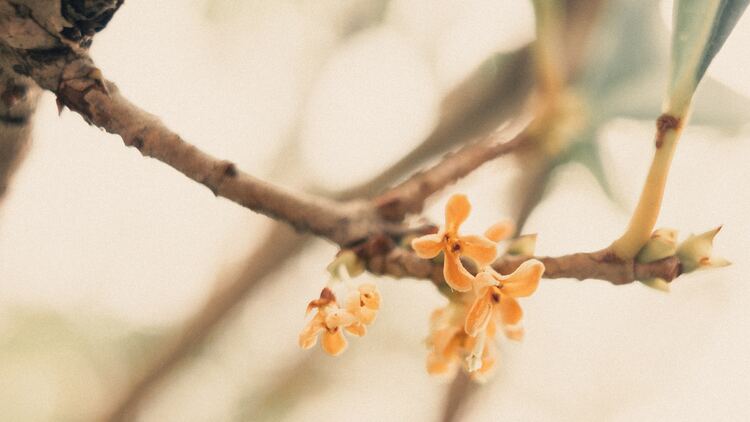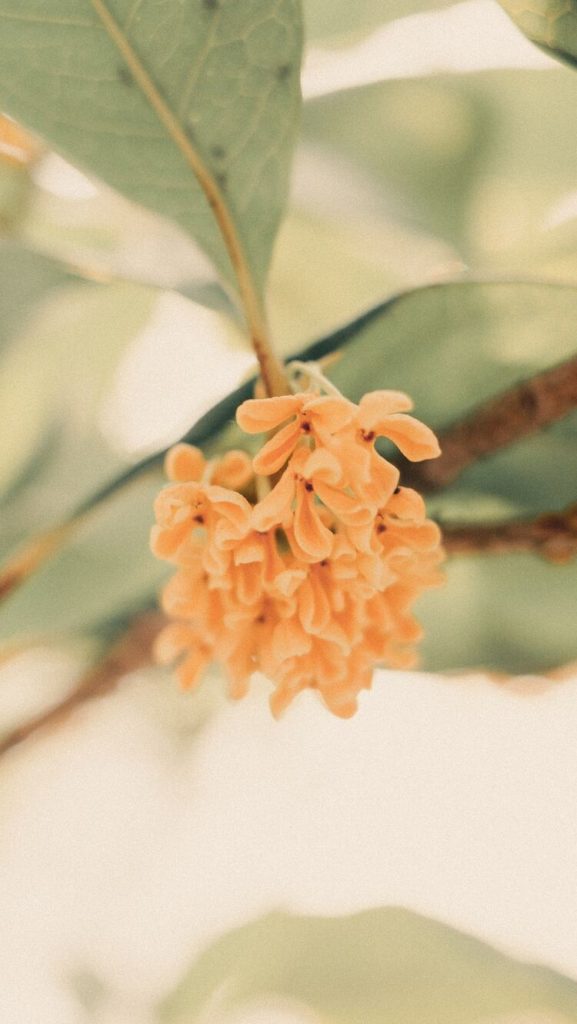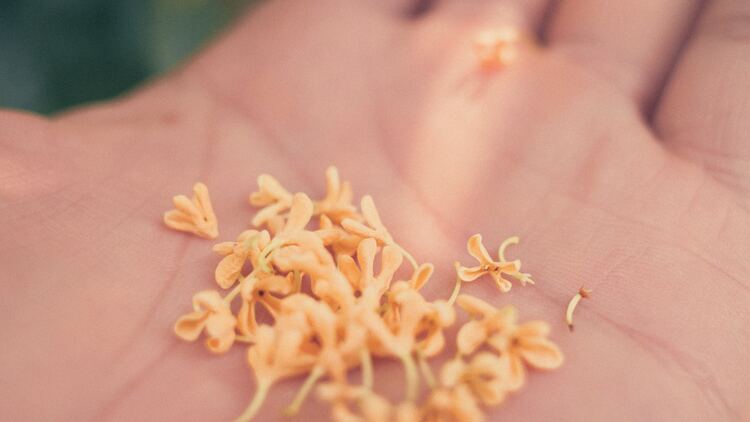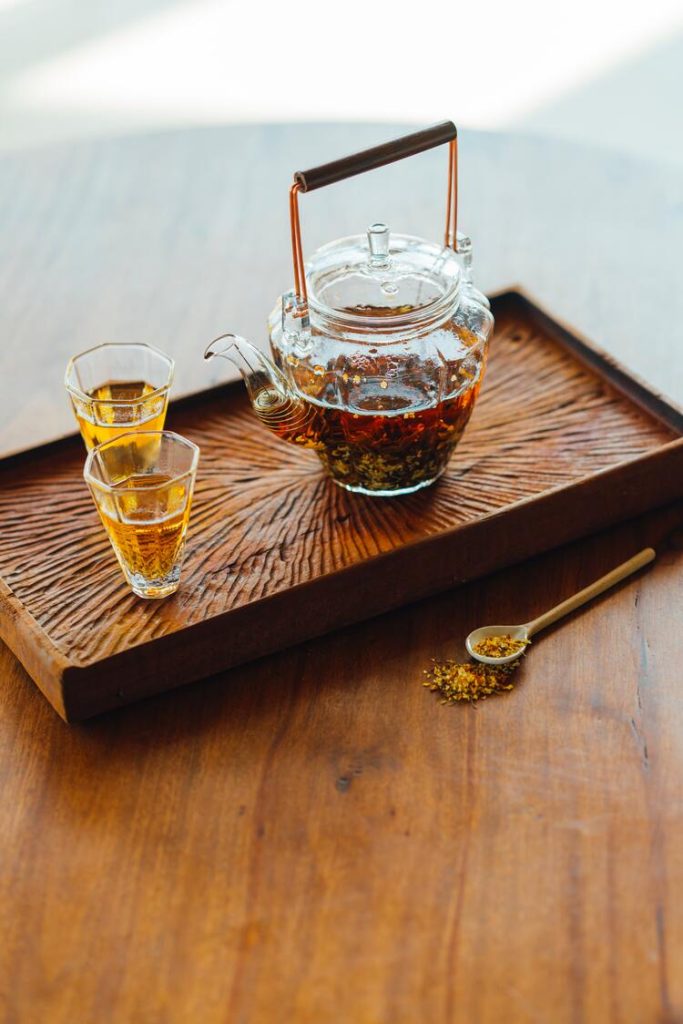What does osmanthus tea taste like?
The flavor of osmanthus tea can be described as a blend of sweet, floral, and fruity notes with a touch of creaminess. It has a soothing, calming effect and often leaves a pleasant aftertaste on your palate. The tea is made from the dried flowers of the osmanthus plant (Osmanthus fragrans), known for its sweet scent and light yellow hue.
Keep reading to learn more about this fragrant infusion!
Please note: This article contains affiliate links, meaning I may earn a commission if you make a purchase by clicking a link. Of course, this comes at no extra cost to you and helps me keep offering readers solid information.

Osmanthus Tea Overview
Osmanthus tea is a floral drink that has been cherished for centuries, particularly in China. The tea pairs delicate osmanthus flowers with high-quality tea leaves, creating a soothing and refreshing flavor.
To make osmanthus tea, you’ll need fresh or dried flowers and a tea of your choice. Traditionally, green or oolong tea is used. Since the green or oolong tea and osmanthus combinations are so well-known, you can acquire a wide variety of blends from tea specialists.
Also, Osmanthus can be enjoyed by itself (without any green or oolong tea added).
What Does Osmanthus Tea Taste Like?
Osmanthus tea offers a gratifying array of flavors and aromas. The taste is primarily sweet and floral, with a hint of honey-like sweetness and a touch of fruity (peaches and apricots) undertones. Some people even detect a touch of vanilla. The sweetness perfectly balances the slightly bitter notes of osmanthus tea, creating a harmonious symphony of flavors in your mouth.
Aroma-wise, the fragrance of osmanthus tea is genuinely captivating. The sweet scent of honey complements the distinct floral aroma. In China, osmanthus tea carries cultural significance and is often enjoyed during the Mid-Autumn Festival. The aroma of the osmanthus flowers is thought to symbolize happiness and good fortune, and they are commonly used to scent teas, desserts, and even wine.
To appreciate the depth of flavors and aroma of osmanthus tea, ensure you brew it correctly. The proper brewing technique (discussed below) will bring out the best in the tea, enhancing its delightful taste and soothing fragrance.
If you are a jasmine-infused tea fan, you should try osmanthus tea.

Types of Osmanthus Tea
Osmanthus tea can be found in several varieties to suit your preferences. Each type possesses unique properties that complement the sweet, peach-like taste of osmanthus flowers.
Pure Osmanthus Tea: If you crave the unadulterated flavor and aroma of osmanthus flowers, pure osmanthus tea is your option. Unlike the blends mentioned below, this tea consists solely of dried osmanthus flowers, offering a refined and concentrated taste experience. Pure osmanthus tea is truly a treat for the senses with its golden liquor and intense floral notes.
Osmanthus Green Tea: This blend pairs the delicate fragrance of osmanthus flowers with the fresh taste of green tea. The result is a light beverage that delights your taste buds and offers potential health benefits from its antioxidant-rich green tea base.
Osmanthus Oolong Tea: Oolong tea, known for its partially fermented leaves, perfectly matches the osmanthus flower’s natural sweetness. The delicate balance between the subtle floral notes and fruity overtones creates a genuinely harmonious and delicious experience in every sip. This blend can be enjoyed hot and cold, making it versatile.
Osmanthus Black Tea: Osmanthus black tea is an ideal choice for a more robust flavor. With its strong and bold taste, black tea brings out the rich, fragrant notes of the osmanthus flowers and creates a delightful, full-bodied beverage that can be enjoyed at any time of day.
Brewing Osmanthus Tea
Brewing osmanthus tea is quite simple. To start, you’ll need some dried osmanthus flowers. You can usually find these at specialty tea shops or online retailers.
Here are the steps to follow:
- Start by heating your water to the right temperature. For this type of tea, it’s best to use water at around 85-90°C (185-194°F). Using boiling water may cause the delicate flowers to lose some unique flavors.
- Measure around 1 teaspoon of dried osmanthus flowers for every 8 ounces (240 ml) of water. Feel free to adjust the flower amount according to your taste preferences, but remember that balance is key.
- Place the dried osmanthus flowers in your preferred tea steeping method, such as a teapot, infuser, or teacup with a lid that can hold the loose flowers. Pour the heated water over the flowers, submerging them completely.
- Allow the tea to steep for about 3-5 minutes. The brewing time may vary depending on your desired strength and flavor. A shorter steeping time will produce a milder taste, while a longer steep will intensify the aroma and flavor.
- Carefully strain the tea into a cup once your tea has reached the desired strength. If you use a teapot, pour the tea through a fine strainer to remove the flowers. Remove the infuser with the dried osmanthus flowers from the tea for those using an infuser.
Now, it is time to enjoy your beverage!
If you are brewing an osmanthus blend (with green, oolong, or black tea), read the package instructions regarding brewing. Ensure you do not overbrew since true teas release bitterness if left too long in hot water.

Health Benefits
Drinking tea made from dried osmanthus flowers can positively impact your overall well-being. As a matter of fact, in Traditional Chinese Medicine (TCM), osmanthus tea has a long history of use.
One of the critical benefits of osmanthus tea lies in its antioxidant content. Rich in polyphenols, it helps in neutralizing free radicals in your body. These antioxidants support your skin’s health by keeping it supple and preventing premature aging.
Another advantage of osmanthus tea is its potential to aid in weight management. The tea’s natural compounds can boost your metabolism and help you burn calories more efficiently. Incorporating this tea into your daily routine can greatly improve your weight loss journey.
Osmanthus tea is also well-regarded for its soothing effect. It helps soothe and relax your nervous system, making it an excellent option for those looking to unwind and reduce stress. The calming properties of osmanthus flower tea contribute to better sleep quality, essential for overall health.
Niacinamide, a component in osmanthus tea, is beneficial for liver health. It may help reduce inflammation and protect against some liver-related diseases. Incorporating osmanthus tea into your diet could contribute to a healthier liver in the long run.
Osmanthus Tea Food Pairings
When it comes to food pairings, here are some options that complement the taste of osmanthus tea:
- Pastries and Desserts: This tea pairs well with pastries and desserts with a mild or light flavor profile. Some suitable options include almond cookies, shortbread cookies, sponge cake, angel food cake, and fruit tarts.
- Fresh Fruits: Enjoy a refreshing combination of osmanthus tea with fresh fruits. Fruits like peaches, apricots, lychees, and oranges work well.
- Honey or Maple Syrup: If you prefer a sweeter cup of osmanthus tea, add a touch of honey or maple syrup. This adds an extra layer of sweetness and blends harmoniously with the floral flavors.
- Light and Savory Snacks: For a contrasting pairing, opt for light and savory snacks. Consider pairing osmanthus tea with cucumber sandwiches, plain rice crackers, or unsalted nuts.
- Rice-based Dishes: Osmanthus can complement rice-based dishes, especially those with subtle flavors. Try pairing it with jasmine rice, plain congee, or rice pudding. The tea adds a hint of fragrance that enhances the overall dining experience.
Remember, taste preferences can vary, so feel free to experiment and find your favorite pairings.

Osmanthus Tea Culinary Uses
In addition to being enjoyed as a beverage, osmanthus tea can also be used in culinary applications. Here are some ideas for your consideration:
- Infused Syrups: Brew a concentrated osmanthus tea by steeping the flowers in hot water. Once the tea has cooled, strain it and combine it with simple syrup (equal parts sugar and water, dissolved together). This osmanthus-infused syrup can sweeten beverages, drizzle over desserts, or add a floral touch to cocktails.
- Jellies and Jams: Add osmanthus tea to your homemade jelly or jam recipes. Steep the tea in hot water and strain it, then use the infused liquid instead of some or all of the water called for in the recipe. The floral notes of osmanthus will add a unique twist to your preserves.
- Baked Goods: Incorporate osmanthus tea into baked goods for a floral twist. You can infuse the tea into the liquids used in recipes such as cakes, muffins, scones, or even custards. Just steep the tea in warm milk or water, strain it and use the infused liquid as directed in the recipe.
- Ice Cream and Sorbets: Make osmanthus-flavored frozen treats by infusing the tea into the base mixture. Heat the cream or milk, steep the tea, and strain before making ice cream or sorbet. The result will be a creamy or fruity dessert with a subtle floral aroma.
- Marinades and Sauces: Create unique marinades and sauces by incorporating osmanthus tea into your recipes. Combine brewed and strained osmanthus tea with soy sauce, ginger, garlic, and other spices to make a flavorful marinade for meats or tofu. To create a sweet and savory sauce, you can also reduce osmanthus tea with sugar and other seasonings.

Buying Recommendations
Hopefully, I have converted you into an osmanthus fan!
If so, go ahead and look for dried osmanthus flowers at your favorite tea specialist or herbal shop. For your convenience, I have listed my top recommendation from an online retailer below.
ELITEA 4oz Dried Osmanthus Flower Herb Loose Leaf Tea

TooGet Fragrant Osmanthus Fragrans Herb Loose Leaf Tea


Plant Gift Organic Sweet Osmanthus Tea

Frequently Asked Questions
Is osmanthus similar to oolong tea in taste?
No, osmanthus tea has a distinct taste compared to oolong tea. While oolong tea has a more robust flavor with a blend of floral and earthy notes, osmanthus tea has a delicate and sweet taste with a hint of peachy undertones.
What are the primary flavors of osmanthus tea?
Osmanthus tea features a sweet, fruity, and floral flavor profile. The primary taste comes from the osmanthus flower itself, which offers a delicate sweetness reminiscent of apricots or peaches. You may also notice subtle floral notes that are refreshing and light.
Does osmanthus tea contain caffeine?
No, osmanthus tea is naturally caffeine-free. It’s an infusion made from the osmanthus flower rather than the tea leaves, making it a great choice for those looking to avoid caffeine or enjoy a beverage in the evening without disrupting their sleep.
Can osmanthus tea help during period?
While there is no concrete scientific evidence that osmanthus tea specifically helps during your period, it has calming effects and can help soothe your nerves. The floral aroma and sweet taste might provide a sense of relaxation and comfort, which could be beneficial during this time. However, it’s essential to listen to your body and consult a healthcare professional if you have concerns.
Are there any side effects associated with osmanthus tea?
Osmanthus tea is generally considered safe for most people. However, some individuals may experience mild allergic reactions, such as itching or skin irritation, if they are sensitive to the osmanthus flower. If you experience any side effects, discontinue use and consult your health practitioner.
What are some health benefits of osmanthus tea?
Osmanthus tea has a reputation for offering various health benefits. Some potential benefits include promoting better digestion, soothing the nerves, and providing antioxidants that can help protect your body against free radicals and oxidative damage. However, it’s important to note that more scientific research is needed to fully understand and confirm these health benefits.
I hope you have enjoyed this article as much as I have! See you next time!
To you, what does osmanthus tea taste like?
More About Floral Teas
What Does Jasmine Tea Taste Like?
What Does Hibiscus Tea Taste Like?
What Does Rose Tea Taste Like?
What Does Rose Milk Tea Taste Like?
What Does Rosehip Tea Taste Like?
What Does Lavender Tea Taste Like?
What Does Lavender Milk Tea Taste Like?
What Does Mullein Tea Taste Like?
What Does Honeybush Tea Taste Like?
More About Tea
What Does Black Tea Taste Like?
What Does Green Tea Taste Like?